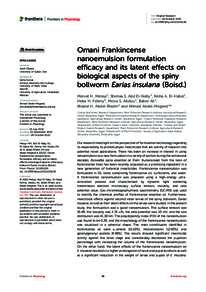Document
Omani frankincense nanoemulsion formulation efficacy and its latent effects on biological aspects of the spiny bollworm earias insulana (boisd.).
Identifier
DOI: 10.3389/fphys.2022.1001136
Source
Frontiers in Physiology. v. 13, 1001136
Contributors
El-Nabyah, Shimaa S. Abd., Author
El-Habal, Noha A., Author
Fahmy, Heba H., Author
Abdou, Mona S., Author
Ali, Baber., Author
Abdel-Rheim, Khaled H., Author
Abdel-Megeed, Ahmed., Author
Country
Switzerland
Publisher
Frontiers Media S.A.
Gregorian
2022-10-06
Language
English
Subject
English abstract
Our research shed light on the perspective of formulation technology regarding its responsibility to provide phyto-insecticides that are worthy of research into potential novel applications. There has been an increase in interest in using nanoemulsion as a new formulation in a variety of sectors during the last several decades. Boswellia sacra essential oil (Fam: Burseraceae) from the resin of frankincense trees has been recently proposed as a promising ingredient in a new generation of botanical insecticides. Frankincense nanoemulsion was formulated in 5% ratios comprising frankincense oil, surfactants, and water. A frankincense nanoemulsion was prepared using a high-energy ultra-sonication process and characterized by dynamic light scattering transmission electron microscopy surface tension, viscosity, and zeta potential value. Gas chromatography/mass spectrometry (GC/MS) was used to identify the chemical profiles of frankincense essential oil. Furthermore, insecticidal effects against second instar larvae of the spiny bollworm, Earias insulana, as well as their latent effects on the larvae were studied. In the present study, the formulation was a good nanoemulsion. The surface tension was 53.69, the viscosity was 4.76 cPs, the zeta potential was-10 mV, and the size distribution was 41.30 nm. The polydispersity index (PDI) of the nanoemulsion was found to be 0.26, and the morphology of the frankincense nanoemulsion was visualized in a spherical shape. The main constituents identified in frankincense oil were α-pinene (15.52%); monolinolenin (12.92%); and geranylgeranyl acetate (9.99%). The results showed significant insecticidal activity against the larval stage and considerably decreased the pupation percentage with increasing the volume of the frankincense nanoemulsion. On the other hand, the latent effects of the frankincense nanoemulsion on E. insulana resulted in a higher prolongation of larval and pupal durations as well as a significant reduction in the weight of larvae and pupae of E. insulana. Additionally, frankincense nanoemulsion dramatically influenced the adult emergence percentage. It also caused a significantly lower hatchability percentage compared to the untreated control. The concentrations used and the types of mating combination have a significant effect on the fecundity of E. insulana. This novel frankincense nanoemulsion formulation could be used in strategies to control the spiny bollworm on cotton plants.
ISSN
1664-042X
Category
Journal articles

